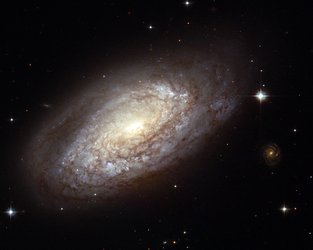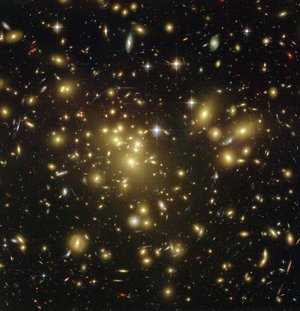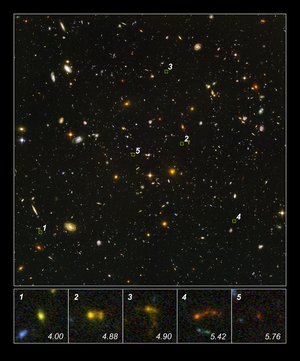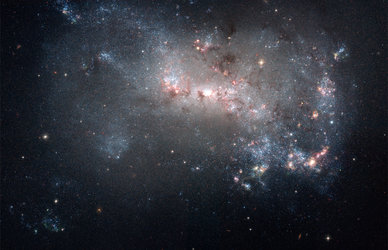Black hole found in Omega Centauri
Omega Centauri has been known to be an unusual globular cluster for a long time. A new result obtained by Hubble and the Gemini Observatory reveals that the globular cluster may have a rare intermediate-mass black hole hidden in its centre, implying that it is likely not a globular cluster at all, but a dwarf galaxy stripped of its outer stars.
Omega Centauri, the largest and brightest globular cluster in the sky, is visible from Earth with the naked eye and is one of the favourite celestial objects for stargazers from the southern hemisphere. Although 17 000 light-years away, it located just above the plane of the Milky Way and appears almost as large as the full Moon when seen from a dark, rural area.
Images obtained with the Hubble Space Telescope’s Advanced Camera for Surveys and data from the GMOS spectrograph on the Gemini South telescope in Chile show that Omega Centauri appears to harbour an elusive and rare intermediate-mass black hole in its centre.
“This result shows that there is a continuous range of masses for black holes - from supermassive, to intermediate-mass, to small stellar mass types”, explained astronomer Eva Noyola of the Max-Planck Institute for Extraterrestrial Physics in Garching, Germany, leader of the team that made the discovery.

Noyola and colleagues measured the motions and brightness of the stars at the centre of Omega Centauri. The measured velocities of the stars in the centre are related to the total mass of the cluster and were far higher than expected from the mass deduced from the number and type of stars seen. So, there had to be something extraordinarily massive (and invisible) at the centre of the cluster responsible for the fast-swirling dance of stars — almost certainly a black hole of about 40 000 solar masses.
“Before this observation, we had only one example of an intermediate-mass black hole — in the globular cluster G1, in the nearby Andromeda Galaxy”, said Karl Gebhardt at the University of Texas, Austin, USA, member of the team that made the discovery. According to Noyola the presence of an intermediate-mass black hole is the most likely reason for the stellar speedway near the cluster’s centre. These intermediate-mass black holes could even be the seeds to create supermassive black holes. This provides astronomers with important new clues to understand one of the possible formation mechanisms of these galactic monsters.

This discovery also has important implications on the very nature of Omega Centauri. Globular clusters contain up to one million old stars bound tightly by gravity and are found in the outskirts of many galaxies including our own. Omega Centauri already has several characteristics that distinguish it from other globular clusters: it rotates faster than average, its shape is highly flattened and it consists of several generations of stars, while typical globular clusters usually consist of just one generation of old stars. It is also about 10 times as massive as other big globular clusters, almost as massive as a small galaxy.
The fact that intermediate-mass black holes may be rare and exist only in former dwarf galaxies that have been stripped of their outer stars, reinforces the idea that Omega Centauri is not a globular cluster but indeed a dwarf galaxy stripped of its outer stars in an earlier encounter with the Milky way.
Notes for editors:

The European Southern Observatory’s Very Large Telescope in Paranal, Chile, will be used to conduct follow-up observations of the velocity of the stars near the cluster’s centre to confirm the discovery.
The finding will be published in the 10 April issue of the Astrophysical Journal in a paper titled ‘Gemini and Hubble Space Telescope Evidence for an Intermediate Mass Black Hole in Omega Centauri’ by Eva Noyola (Max Planck Institute for Astrophysics in Germany & University of Texas, Austin, USA), Karl Gebhardt (University of Texas, Austin) and Marcel Bergmann (Gemini Observatory).
The Hubble Space Telescope is a project of international cooperation between NASA and ESA.
For more information:
Eva Noyola, Max-Planck Institute for Astrophysics, Garching, Germany/University of Texas, USA
E-mail: Noyola @ mpe.mpg.de
Lars Lindberg Christensen, Hubble/ESA, Garching, Germany
E-mail: Lars @ eso.org
Ray Villard, Space Telescope Science Institute, Baltimore, USA
E-mail: Villard @ stsci.edu
Peter Michaud, Gemini Observatory, Hilo, Hawaii, USA
E-mail: PMichaud @ gemini.edu
















